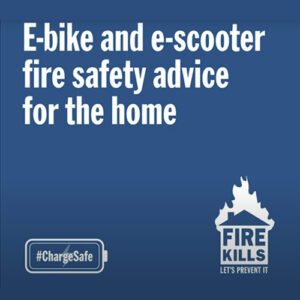Electric bike and scooter safety
With more people using e-bikes or e-scooters to get around, it is important to know how to charge them safely and correctly.
Things to consider if you own an e-bike or e-scooter:
- Most e-bikes and e-scooters are powered by lithium-ion batteries, which if not looked after properly, can ‘explode’ and lead to a rapidly developing fire.
- Fire services and fire investigators have seen a significant rise in e-bike and e-scooter battery fires.
- Firefighters were called to more than 130 fires involving e-bike and e-scooter batteries in London in the last year.
- The incorrect disposal of lithium-ion batteries in general household and recycling waste can also lead to significant waste fires.
Please remember when charging at home, you do so safely to avoid the risk of a fire starting, putting you, your home and neighbours’ homes at risk.
For easy to understand advice about charging e-bike and e-scooter batteries, please access this video produced by Fire England.
The London Fire Brigade have a wealth of information about safely charging e-bikes and e-scooters.
Please follow these important safety tips around e-bikes and e-scooters:
Charging
- Follow the manufacturer’s instructions when charging and always unplug your charger when finished.
- Ensure you have working smoke alarms.
- Don’t leave batteries to charge while you are asleep or away from home.
- Always use the manufacturer approved charger. If you spot any signs of damage, buy an official replacement from a reputable seller.
- Don’t cover chargers or battery packs when charging as this could lead to overheating or a fire.
- Don’t charge batteries or store your e-bike or e-scooter near combustible or flammable materials.
- Don’t overcharge your battery – check the manufacturer’s instructions for charge times.
- Don’t overload socket outlets or use inappropriate extension leads.
- In the event of an e-bike, e-scooter or lithium-ion battery fire, don’t attempt to extinguish the fire. Get out and call 999.
Storage
- Avoid storing or charging e-bikes and e-scooters on escape routes or in communal areas.
- Store e-bikes, e-scooters and their batteries in a cool place. Avoid storing them in excessively hot or cold areas.
- Follow manufacturer’s instructions for the storage and maintenance of lithium.
Buying
- Buy e-bikes, e-scooters, chargers and batteries from reputable retailers.
- Many fires involve counterfeit electrical goods. Items which don’t meet British or European standards pose a huge fire risk.
- If you are buying an e-bike conversion kit, purchase from a reputable seller and check that it complies with British or European standards. Take particular care if buying from online platforms. Also be aware that if buying separate components, you should check that they’re compatible.
- Register your product with the manufacturer to validate any warranties.
- Check any products you have bought are not subject to a product recall: Electrical Safety First’s website (Product Recalls & Safety Notices).
Damage and disposal
- Check your battery regularly for any signs of damage. If damaged, it should be replaced and shouldn’t be used or charged – damaged batteries can overheat and catch fire without warning.
- If you need to dispose of a damaged or end of life battery, don’t dispose of it in your household waste or normal recycling. These batteries, when punctured or crushed, can cause fires in bin lorries, recycling and waste centres. Your e-bike or e-scooter manufacturer may offer a recycling service. Alternatively, check with your local authority for suitable battery recycling arrangements.
Finally
- Ensure you are riding your e-bikes and e-scooters within the law. See further information on the Gov.uk website: e-bike rules and e-scooter trials.